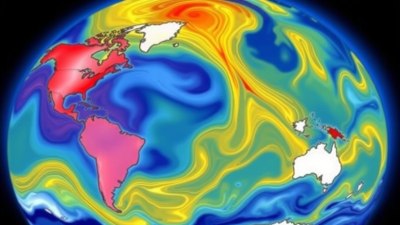What 'Feels Like' Temperature Actually Measures
Explore the science behind 'feels like' temperature and how factors like humidity, wind, and sunlight influence how hot or cold it actually feels.

Image created with Flux Schnell
When you check the weather forecast, you might see two different temperature readings: the actual air temperature and the "feels like" temperature. But what exactly is the "feels like" temperature, and why can it be quite different from the thermometer reading? This article will unravel the science behind this concept, explaining how and why our bodies perceive temperature differently from the actual air temperature.
At its core, the "feels like" temperature is a measure of how the weather conditions affect human perception of temperature. It takes into account not just the air temperature but also other atmospheric elements such as wind speed, humidity, and sunlight, which influence the body's heat exchange with the environment. Unlike the straightforward measurement of air temperature, the "feels like" temperature is a subjective indicator calibrated through scientific models that simulate the human body's thermal response.
The Basis of Temperature Measurement
Thermometers give us a standard or air temperature — a direct reading of how hot or cold the surrounding air is. This measurement, however, does not always align with how we feel. For example, on a windy winter day, the thermometer might read 30°F (-1°C), but it could feel much colder due to wind making it harder for our bodies to retain heat. Conversely, during hot, humid summer days, the air temperature might be 90°F (32°C), but the moisture in the air can make it feel hotter than what the thermometer actually indicates.
The disparity arises because human perception of temperature is influenced by the body's thermal balance, which depends on heat production, heat loss, and the environment's effect on heat exchange. Several factors contribute to this heat exchange: conduction, convection, radiation, and evaporation, each affecting how hot or cold we feel.
Key Factors Affecting 'Feels Like' Temperature
1. Wind Chill
Wind can significantly accelerate heat loss from the body, especially in cold conditions. When the wind blows over exposed skin, it removes the thin layer of warm air trapped near the skin's surface through convection, making the body lose heat faster than it would in calm conditions. This phenomenon is known as wind chill. Meteorologists use wind chill index formulas to estimate the temperature equivalent that would cause the same rate of heat loss on a calm day.
The wind chill temperature is always lower than or equal to the actual air temperature when cold winds are present, signifying increased cold stress on the body. This is particularly important for outdoor safety, as it indicates the risk of frostbite and hypothermia at temperatures that might otherwise not seem dangerously low.
2. Heat Index
In hot weather, humidity plays a critical role. The heat index combines air temperature and relative humidity to describe how hot it actually feels. When humidity is high, sweat evaporates more slowly, hindering the body's natural cooling process. As a result, even if the air temperature is moderate, the moist air makes the body feel hotter and increases heat stress.
The heat index provides a value often higher than the air temperature, warning about the risks of heat exhaustion and heat stroke. This altered perception helps guide public health warnings in the summer months.
3. Solar Radiation
Sunshine can alter the "feels like" temperature in multiple ways. Direct sunlight warms the skin and clothing, adding to the perceived temperature beyond the air temperature. This extra radiant heat can make a shaded thermometer reading less representative of actual conditions experienced by people in the sun. Additionally, solar radiation influences how quickly heat is absorbed or released from surrounding surfaces, affecting local microclimates.
4. Humidity Beyond Heat Index
While humidity's impact is most commonly discussed in hot weather through the heat index, it also influences how cold we feel. Dry air can enhance evaporative cooling, which sometimes makes air feel cooler in winter compared to humid air at the same temperature. However, this effect is much less pronounced than in hot weather.
How the Human Body Senses Temperature
The human body maintains its internal temperature around 98.6°F (37°C) through a delicate balance of heat production and heat loss. Thermoreceptors in the skin, especially in areas like the face and hands, detect changes in external temperature and send signals to the brain. This perception can be influenced by various environmental factors, explaining why sometimes we feel colder or warmer than what the air temperature alone suggests.
Our bodies primarily lose heat through four mechanisms:
1. Conduction: Direct transfer of heat through contact with cooler surfaces or air.
2. Convection: Heat loss via movement of air or water across the skin.
3. Radiation: Emission or absorption of infrared radiation, including effects from the sun.
4. Evaporation: Cooling through evaporation of sweat.
The "feels like" temperature models incorporate these mechanisms as much as possible to estimate an equivalent temperature value that captures the combined effect.
Common Formulas and Models for 'Feels Like' Temperature
Different meteorological agencies use specific formulas and indices to express the "feels like" temperature, often depending on the season and predominant conditions:
Wind Chill Index: This index uses air temperature and wind speed to estimate how cold it feels in winter. The most widely accepted formula in the U.S. was developed by the National Weather Service and applies to temperatures at or below 50°F (10°C) and wind speeds above 3 mph (4.8 km/h).
Heat Index: Often called the "apparent temperature," this combines air temperature and relative humidity, reflecting how hot it feels during warm conditions. The formula takes into account the decreased cooling efficiency of sweat evaporation at higher humidity levels.
Humidex: Used primarily in Canada, the humidex is similar to the heat index but uses dew point instead of relative humidity to measure discomfort related to heat and humidity.
Apparent Temperature: Some meteorologists use an overall apparent temperature that includes solar radiation and other factors to provide a more comprehensive assessment.
Why 'Feels Like' Temperature Matters
The "feels like" temperature is more than just an interesting fact; it has practical implications for health, safety, and comfort. Understanding this value helps individuals dress appropriately, plan outdoor activities, and recognize potentially dangerous weather conditions. For example:
- In cold weather, knowing the wind chill helps prevent frostbite and hypothermia by highlighting the increased risk due to wind.
- In hot weather, the heat index warns about heat stress and guides hydration and activity recommendations.
- For athletes, outdoor workers, and vulnerable populations, the "feels like" value enables better preparation and risk mitigation.
Limitations and Variations in 'Feels Like' Temperature
While the concept is useful, the "feels like" temperature remains an estimate that varies between individuals and environments. Factors like clothing, activity level, acclimatization, and personal physiology can cause different people to perceive the same conditions differently.
Additionally, urban heat islands, shade availability, altitude, and microclimate variations mean that the local "feels like" temperature might differ from the generalized forecast for an area.
Some modern weather apps incorporate additional data like UV radiation, air quality, or barometric pressure to provide nuanced comfort indices, but the basic principles remain grounded in the physics of heat transfer and human thermal sensation.
Interpreting 'Feels Like' Temperature in Daily Life
When you see the "feels like" temperature, use it as a guideline rather than an absolute rule. Consider the conditions you’ll spend time in — are you in the sun, shade, wind, or sheltered indoors? Will you be moving and generating body heat, or standing still? Adjust your clothing and hydration needs accordingly.
For parents, elderly individuals, and those with medical conditions, paying attention to the "feels like" temperature helps in preventing weather-related illnesses and improving comfort.
Future Developments in Weather Perception Indices
Advancements in meteorology and wearable technology aim to create personalized weather comfort indices that consider individual biometrics such as skin temperature, heart rate, and sweat rate in real-time. These tools could provide even more accurate "feels like" temperatures tailored to personal conditions and locations, helping users optimize safety and comfort in changing weather.
Until then, the scientifically derived "feels like" temperature remains a valuable tool for understanding how external environmental factors collectively impact our thermal experience beyond the simple air temperature measurement.
Understanding the "feels like" temperature improves our connection with our environment, encourages safer outdoor behavior, and highlights the complex interplay between climate and human health.











